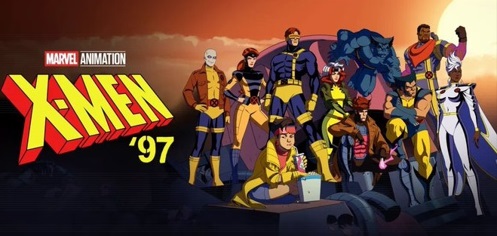English Dub Review: Darwin’s Game; “First Game”
Overview (Spoilers Below)
High-schooler Kaname is mercilessly thrust into a game of life and death, forcing him to battle crazed, super-powered combatants.
Our Take
The first episode of this anime is a double-length feature for whatever reason. It’s nice though because it allows the show to get off to a stronger start. But it does mean the anime will be one less episode longer than normal, which is fine.
The show opens with a young man running fiercely for his life, cursing his fate along the way. He begins weighing his options and tries to contact a friend for help when he’s driven into a corner. Pursuing him is an invisible being wearing a bear mascot costume. He launches some sort of attack, but it is futile and the bear mascot slices his neck open cleanly. When he dies, the bass in the music drops, then stops, then his neck opens up like a fire hose, spraying blood in a humongous arc while he convulses rapidly.
This image sounds gross, and it certainly is, but in practice, it comes off as needlessly goofy. It’s so over-the-top violent that it becomes ridiculous and I couldn’t help but laugh at it. This first scene, in all of its crudeness, serves as a good window into this show; a death game story with lots of splattery fan-service.
We enter Kaname, our protagonist who seems to be concerned with purchasing a motorcycle and little else. One of his friends brings to his attention pictures of weird graffiti that has been popping up. Throughout the town, outlines in the shape of people are being carved into the pavement. These are obviously the outlines of the people who are killed in the death game.
Another one of Kaname’s friends, Kyoda, walks up to him and desperately asks about Hamada, another friend of theirs. When Kaname has nothing, Kyoda’s exasperation intensifies, signaling that Hamada was the person we saw die at the beginning. The show wastes no time plunging us into the action, not even sparing the lives of high schoolers.
The narrative mercilessness accelerates even further as Kaname’s phone installs a free-to-play game for him called “Darwin’s Game.” Kyoda warns him not to open it; a snake emerges from his phone and bites him, rendering him unconscious.
Kaname awakens feeling bad and heads home. On the train, he examines the freshly installed Darwin’s Game and is immediately put into a battle against Banda, the bear mascot from before, who is also conveniently on the train. As the battle starts, Banda approaches him at an eerily slow pace, allowing Kaname enough time to both mentally process this and dodge his attack.
Banda’s design is right at home for the first enemy in a death game. The creepy panda bear costume wearing a baseball jersey with the number 666 sits squarely on the nose. But his first attack is so slow that it’s generous. Why wouldn’t he attack Kaname as fast as possible to secure the win? He’s touted as the “rookie killer;” perhaps he likes giving rookies a small chance at first.
When Kaname realizes this isn’t a joke, he runs for help to no avail from the passersby. He heads to a police station and enlists the help of an officer who is quickly cut down by Banda. Fortunately, Kyoda seems to have followed him and is able to shoot Banda with a crossbow he happened to bring.
Here, Kyoda reveals one of the win conditions: escaping and staying away for a certain length of time. Banda shows off his invisibility once again, but Kyoda conveniently has the ability to counter, though not without incurring major damage.
Kaname brings the injured Kyoda with him to a parking garage and futilely calls for an ambulance. Kyoda explains that during a match combatants cannot contact anyone outside. He also explains that Banda can only track Kaname as he is the combatant in the battle. Kaname leaves Kyoda behind to deal with Banda alone but vows to bring help to Kyoda when he can.
Kaname and Banda have their battle in the parking garage. Banda’s power to become invisible is put on full display, showing that he can even turn objects he touches invisible as well. Just as the fight turns dicey for Kaname, Banda is conveniently hit by a car and ends up losing the match. As a result of this, Banda is slowly deleted Tron-style, bit by bit in square chunks, leaving behind the telltale body outline. Sadly, Kyoda is also deleted in this manner.
At first, it seems being deleted like this is what happens when you lose a battle. But later, it is revealed that this is what happens when you lose all of your points in the game. Banda losing all of his points makes sense since he was wagering them in the battle. But why did Kyoda get deleted? He wasn’t a participant. Did involving himself put him in the battle? And if so, how exactly did he lose points in that battle since he was on Kaname’s side? The finer details of how this game works will be revealed in due time, but even then, this seems like a questionable scenario.
The next couple of scenes introduce us to a few characters. First, we see a gang of street punks gratuitously slaughter some yakuza in cold blood. These characters will definitely pop up later, but the purpose of this scene is to establish that there are clans within Darwin’s Game. Second, we are introduced to Shuka, a young woman who clearly has some sort of psychosis as she actually enjoys playing this death game.
Kaname takes the deaths of two of his friends relatively well considering the circumstances. His phone beeps with the results of his victory, earning some points, ranking up, and unlocking a gacha function (truly the devil’s game). He does a one-pull on the gacha and wins a pistol, which is eerily delivered to him instantly, Amazon-style.
Kaname had been receiving messages from Shuka up until this point, her badgering him to meet up with her. He decides he wants answers, fully arms himself, and heads to a warehouse to question her.
The first question he has is how to quit the game; unfortunately, it doesn’t appear that you can. Presumably, based on the name of the game, the primary objective is just to kill others and rack up points in perpetuity to become the fittest of them all. Shuka then asks Kaname what his “Sigil” is, referring to the superpower each combatant is granted at the start of the game. Kaname has no idea what his Sigil is and the game’s information screen gives him an error message.
Dissatisfied that Kaname isn’t what she thought he would be, Shuka decides to just kill him. Kaname is able to stop her for a little while with some ingenuity, but her ability to control her bladed chain freely puts him at a large disadvantage.
At this point, Kaname launches into an internal monologue. His pitiful, desperate self argues with a more hardened part of himself, determining if he has the will to survive. As he questions himself, bold characters are thunderously superimposed over a lone flame. While the threat of death justifies this sort of scene, the execution is decidedly over-dramatic. Regardless, this monologue serves its function and Kaname is able to ascertain his Sigil: the ability to create objects he has seen before out of thin air.
With an incredible amount of ingenuity and bluster, Kaname sets up a trap to lure Shuka into a corner, rushes head-on through her attacks, pins her down and puts the pistol in her face. However, when given the prime opportunity to kill her, he emphatically refuses, declaring that they will both survive. Shuka reveals another way one can lose a battle: surrendering on the condition that the loser serves under the victor.
The episode ends with Kaname waking up topless in Shuka’s bed, with her completely naked and requesting to start a family together. With Shuka, Kaname earns two gross anime tropes for the price of one; unnecessary sexual tension and unnecessary forced romance. Hopefully, Shuka’s helpfulness in these upcoming battles outweighs the annoyance she will certainly be.
So far this is a relatively standard death game affair. The addition of superpowers acts as an equalizer, allowing for a more even battlefield and the opportunity for one’s wits to overcome brute strength. These sorts of multi-layered mind games are more appealing than simply spilling fountains of blood, though I have no doubt we’ll be seeing more gore as well.
The animation also seems to reflect the show’s narrative priorities. The movement and the action are serviceable, and a lot of effort went into the blood effects. However, the character designs seem rather lazy, with oddly-shaped, inconsistent eyes and just a general sense that everything seems a little off.
The show also likes to employ liberal use of sharp bass drops in the score. The bass drop has grown a little tired over the years, but if used decisively, it can still elicit tension. Here, however, it is used far too often and each instance contains far too much of it. The bass spends more time preparing to drop than it does actually dropping, so you can anticipate a big explosive moment before it even happens, which sort of spoils the plot by a few seconds.
The opening animation placed at the end of the first episode shows off that there are many villains in this game. With only 11 episodes to utilize, I doubt we’ll be seeing that many. It also seems unlikely that we’ll be reaching any sort of hard resolution at the end. Hopefully, the journey to whatever end that is is compelling enough to justify taking it.



























Hi Ashley, thank you so much for reading and we love the feedback. Note that on that day we had 14th posts go up and only ten posts show on the front page, so it's possible the preview had already been archived by the time you got to it. One recommendation would be to add our RSS feed to your favorite news aggregator service like Feedly, this way you get all of the latest posts!